- Read the Case example in the Family Systems and Chemical Dependency reading (located in Unit 2-Substance Use Disorders under readings) (pages 23-30). Depending on the device you are opening this reading in the page numbers may be different. If you look through the reading, you will come across the Case Example. Your responses need to be written in complete and detailed responses.
- Identify 2 specific things you felt the counselor did well, and provide your rationale.
Identify 1 specific thing you were surprised the counselor did, or did not do and provide your rationale
- Discuss your overall thoughts about the case example (5 - 10 sentences is required).
- Read and comment on 3 of your peers' responses. You will need to complete your Discussion post before you're able to view and comment on your peers discussion posts.

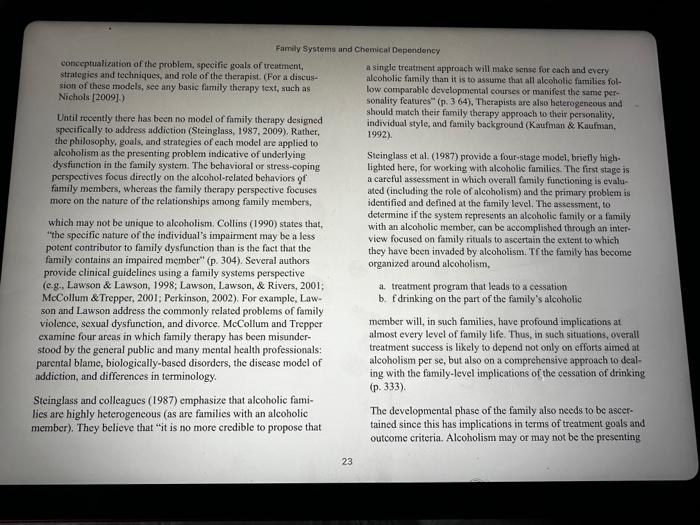
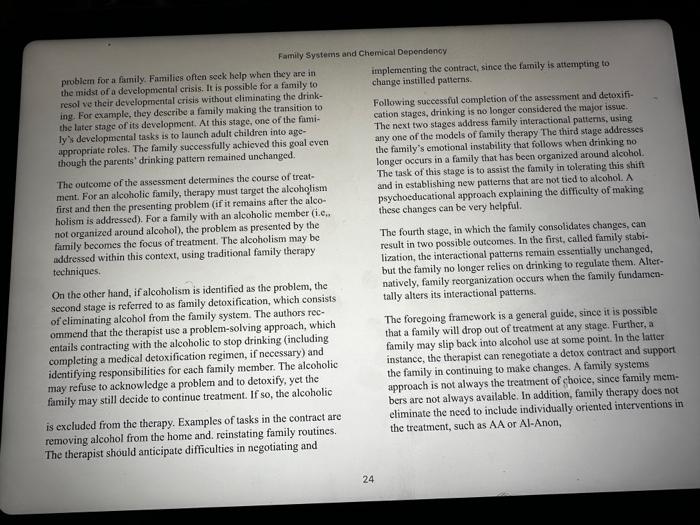

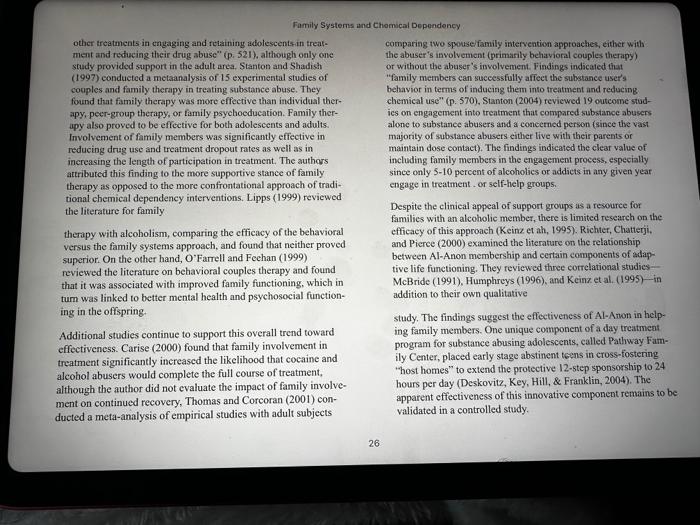
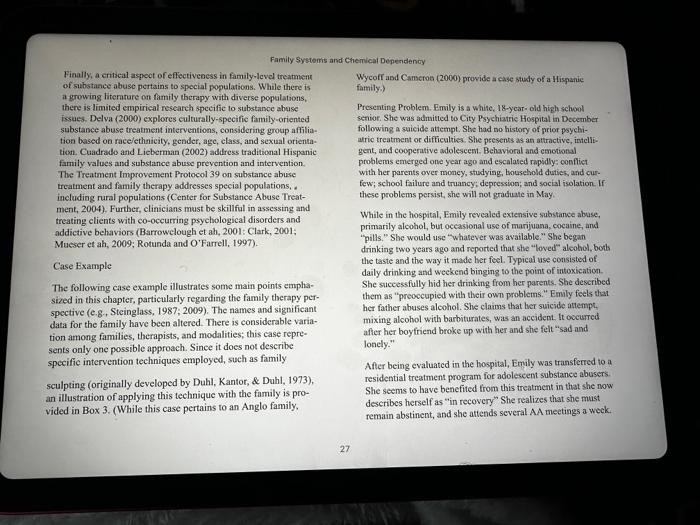
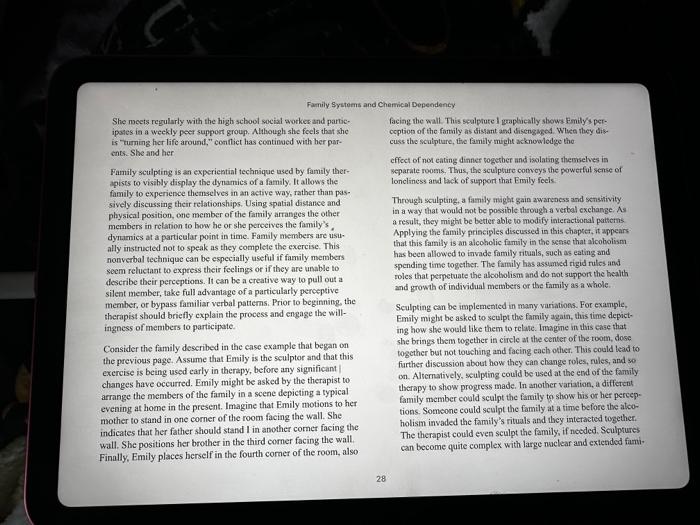
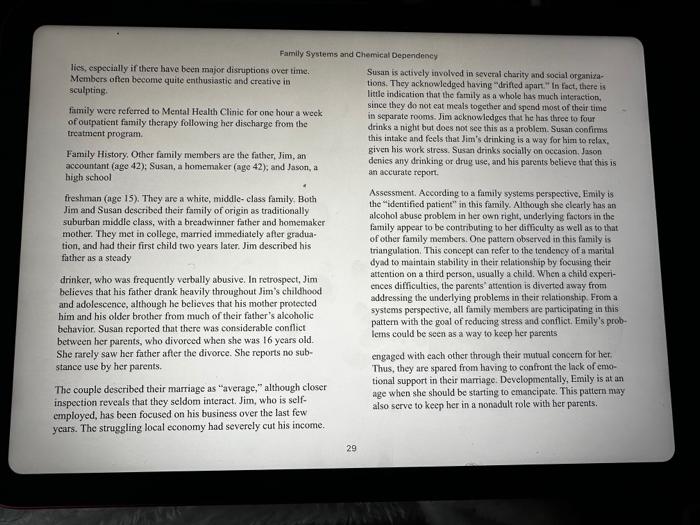
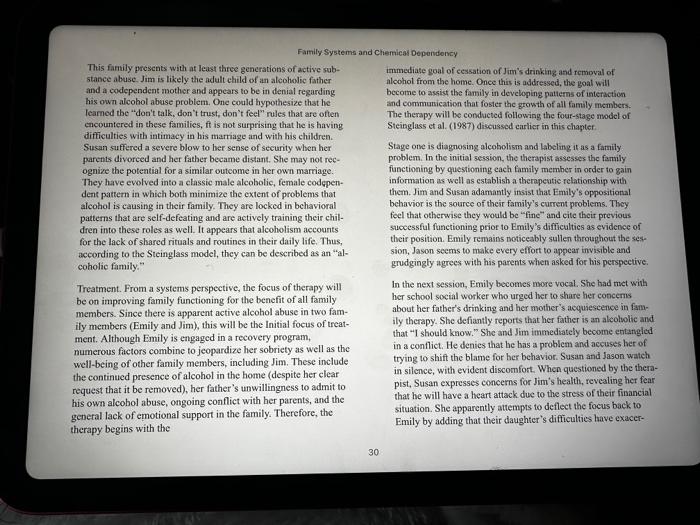
This is a 'post-first' discussion forum. There are currently 17 threads in this fortum. Join the conversation by creating a thread! Writhen in complete and detaled nesponse: 4. Discuis your oreral theughte nbout the case exampel (5- 10 sentancos is required) Family Systems and Chomicat Dependoncy conceptualization of the problem, speciffe goals of treatment, strategies and techniques, and role of the therapist (For a discusa single treatment approuch will make sense for each and every sion of these models, see any basic family therapy text, such as Nichols (2009].) low comparable developmental courses or manifest the same personality features 1 (p. 364). Therapists are also beterogeneous and Uatil recently there has been no model of fumily therapy designed should match their family therapy approach to their personality, specifically to address addiction (Steinglass, 1987, 2009). Rather. individual style, and family background (Kaufman \& Kaufinan. the philosophy, goals, and strategies of each model are applied to alcoholisen as the presenting problem indicative of underlying 1992). dysfunction in the family system. The belavioral or stress-coping Steinglass et al. (1987) provide a four-stage model, briefly highperspectives focus directly on the alcohol-related behaviors of lighted here, for working with alcoholic families. The first stage is. family members, whereas the family therapy perspective focuses. a careful assessment in which overail family functioning is evalumore on the nature of the relationships among family members, ated (including the role of alcoholism) and the primary problem is identified and defined at the fumily level. The assessment, to which may not be unique to alcoholism. Collins (1990) states that, determine if the system represents an alcoholie family or a family "the specific nature of the individual's impairment may be a less an alcoholic member, can be accomplished through an interpotent contributor to family dysfunction than is the fact that the view focused on family rituals to ascertain the extent to which family contains an impaired member" (p. 304). Several authors they have been invaded by alcoholism. Tf the family has become provide clinical guidelines using a family systems perspective (e.g, Lawson \& Lawson, 1998; Lawson, Lawson, \& Rivers, 200I; organized around alcoholism, MoCollum eeTrepper, 2001; Perkinson, 2002). For example, Lawa. treatment program that leads to a cessation son and Lawson address the commonly related problems of family violence, sexual dysfunction, and divorce. McCollum and Trepper b. f drinking on the part of the family's alcoholic examine four areas in which family therapy has been misundermember will, in such families, bave profound implications at stood by the general public and many mental health professionals: almost every level of family life. Thus, in such situations, overall parental blame, biologically-based disorders, the discase model of treatment suceess is likely to depend not only on efforts aimed at addiction, and differences in terminology. alcoholism per se, but also on a comprehensive approach to dealing with the family-level implications of the cessation of drinking Steinglass and colleagues ( 1987) emphasize that alcoholic fami(p. 333). lies are highly heterogeneous (as are families with an alcoholic The developmental phase of the family also needs to be ascermember). They believe that "it is no more credible to propose that tained since this has implications in terms of treatment goals and outcome criteria. Alcoholism may or may not be the presentimg problem for a farmily. Families often seck help when they are in implementing the contract, since the farnily is attempting to the aridst of a developmental crisis. It is possible for a family to resol ve their developmertal crisis without eliminating the drinking. For example, they deseribe a family making the transition to the later stage of its development. At this stage, one of the family i developmental tasks is to taunch adult children into agechange instilled patterns. appropriate roles. The family successfully achieved this goal even though the parents' drinking pattem remained unchanged. Following suceessfial completion of the assessment and detoxification stages, drinking is no longer considered the major issue. The outcome of the assessment determines the course of treatThe next two stages address family interactional patterns, using ment. For an alcoholic family, therapy must target the alcoholism first and then the presenting problem (if it remains after the alcoany one of the models of family therapy The third stage addresses holism is addressed). For a family with an alcoholic member (i.e,. the family's emotional instability that follows when drinking no not organized around alcohol), the problem as presented by the family becomes the focus of treatment. The alcoholism may be addressed within this context, using traditional family therapy longer oceurs in a family that has been erganized around alcohol. techniques. The task of this stage is to assist the famtly in wolerating this shift and in establishing new patiems that are not tied to alcohol A psychoeducational approach explaining the difficulty of making these changes can be very helpful. On the other hand, if alcoholism is identified as the problem, the second stage is referred to as family detoxification, which consisis of eliminating alcohol from the family system. The authors recommend that the therapist use a problem-solving approach, which The fourth stage, in which the family consolidates changes, can alting a medical detoxificat ng responsibilities for each family member. The alcoholic but the family no longer relies on drinking to regulate them. Alternatively, family reorganization occurs when the family fundamentally alters its interactional pattems. family may still decide to continue treatment. If so, the alcoholic The foregoing framework is a general guide, sinee it is that a family will drop out of treatment at any stage. Further, a family may slip back into alcohol use at some point. In the latter instance, the therapist can renegotiate a detox contract and support the family in continuing to make changes. A family systems approach is not always the treatment of choice, since family members are not always available. In addition, family therapy does not is excluded from the therapy. Examples of tasks in the contract are eliminate the need to include individually oriented interventions in removing alcohol from the home and. reinstating family routincs. the treatment, such as AA or Al-Anon, The therapist should anticipate difficulties in negotiating and Family Systoms and Chemical Depondency Steinglass (2009) has refined his fainily systems treatment model for substance abase to include motivational interviewing, calling this newly integrated approach systemic-motivational interviewing (SMI). Motivational iaterviewing was developed in the 19805 is an alternative atathors point out that no other treatment has been shown to be asy more effective in producing desirable changes in behavior. OFazre11, Murphy, Alter, and Fais-Stewart (2005) observe that "mets analytic reviews indicate that involving the family in the paticnt's treatment generally is at effective theass to promote recovery. to confrontational techniques that were widely used in the United from aleoholism and drug abuse" (p,464). In another recent States but deemed ineffective. It is regarded as more bumanistic review, Copelio, Velicman, and 'Templeton (2005) atso conclude and coasistent with harn reduction and relapse prevention that family involvemeat in substance misuse treatment can be approaches. Preliminary data indicate it is effective with individuals, but there is no research on couples or familics. Since SMI is based on prior empirical evidence of both family therapy and substance abuse treatment, Steinglass contends that it has strong face validity. SMI specifically targets the underlying belief system, very effective. Austin, Ma cgo wan, and Wagner (2005) particularly regarding ambivalence about change, felt by all mem-_ (as do Crespi \& Rucekert, 2006 ), that family therapy can only be bers of the family. In this model, there are three stages: assessment and consultation, family-level treatment, and aftercare and relapse prevention. Steinglass postulates that one promise of this model is that it "potentially bridges the divide currently separating summarize family-based intervention approsehes that have sbown promise in carly controlled studies, but add that these findings: require replication by independent investigators. They also note the worlds of family therapy and substance abuse treatment" (p. effective if it is implemented properly; both articles call for elini171). cians to be properly trained. Effectiveness of Family Treatment There are several earlier noteworthy studies of Iamily-oriented approaches that indicate effectiveness. Edwards and Steinglass (1995)" "reviewed findings from twenty-one stodies investigating: the efficacy of family therapy as a treatment for alcoholism and found evidence to support the potential usefulness of including family members in all three phases of alcoholism treatment-initi- Data on the effectiveness of treatment for alcoholism are often ation of treatment, primary treatment rehabilitation, and aftereare" equivocal, as relapses rates remain high. This same pattern applies (p. 500). No single family therapy approsch was shown to be. to studies that examine the effectiveness of family-level intervenmore effective, and some family variables influencod the findings fion, although there is general support for the positive outcomes of (i.e., gender of the identified alcoholic, commitment to andior satfamily therapy for alcoholism and substance misuse (e.g. isfaction with the marriage, and spousal support for abstinence). Edwards \&e Steinglass, 1995; Steinglass, 1987, 2009; Steinglass et Liddle andDakof (1995) examined controlled treatment outeome ah, 1987), Although acknowledging limitations of the data, these research of family therapy for drug abuse in both adolescents and adults. They found "'family therapy.. to be more effective than other treatments in engaging and retaining adolescentsin treatment and reducing their drug abuse" (p. 521), although only one comparing two spouse/family intervention approaches, either with: study provided support in the adult arca, Stanton and Shadish the abuser's involvement (primarily behavions couples therapy) (1997) conducted a metsanalysis of 15 experimental studies of or without the abuser's involvement. Findings indicated that couples and family therapy in treating substance abuse. They "family members can successfully affeet the substance user's found that family therapy was more effective than individual therbehaviot in terms of inducing them into treatment and reducing apy, peer-group therapy, or tamily psychoeducation. Family therapy also proved to be effective for both adolescents and adults. chemical use" (p. 570), Stanton (2004) reviewed 19 outcone studInvolvement of family members was significantly effective in alone to substance abusers and a concerned person (since the vast reducing drag use and treatment dropout rates as well as in majority of substance abusers cither live with their parents of increasing the length of participation in treatment. The authors maintain dose contact). The findings indicated the clear value of attributed this finding to the more supportive stance of family. including family members in the engagement process, especially therapy as opposed to the more confrontational approach of tradisince only 510 percent of alcoholics or addiets in any given year tional chemical dependency interventions. Lipps (1999) reviewed engage in treatment - or self-help groups. the literature for family Despite the clinical appeal of support groups as a resource for therapy with alcoholism, comparing the cfficacy of the behavioral efficacy of this approach (Keinz et ah, 1995). Richter, Chatierji. versus the family systems approach, and found that neither proved and Pierce (2000) examined the literature on the relationship superior. On the other hand, O'Farrell and Feehan (1999) between Al-Anon membership and certain components of adapreviewed the literature on behavioral couples therapy and found tive life functioning. They reviewed three correlational studies that it was associated with improved family functioning, which in McBride (1991). Humphreys (1996), and Kcinz et al. (1995) -in tum was linked to better mental health and psychosocial functionaddition to their own qualitative ing in the offspring. Additional studies continue to support this overall trend toward study. The findings suggest the effectiveness of Al-Aron in helpeffectiveness. Carise (2000) found that family involvement in ing family members. One unique component of a day treatment treatment significantly increascd the likelihood that cocaine and program for substance abusing adolescents, called Pathway Famalcohol abusers would complete the full course of treatment, "host homes" to extend the protective 12-step sponsorship to 24 although the author did not evaluate the impact of family involvehours per day (Deskovitz, Key, Hill, \& Franklin, 2004). The ment on continued recovery, Thomas and Corcoran (2001) conapparent effectiveness of this innovative component remains to be ducted a meta-analysis of empirical studies with adult subjects validated in a controlled study. Family Systomis and Chemical Dependency Finally, a eritical aspeot of effectiveocss in family-lovel treatmen of substance abuse pertains to special populations. While there is Wycoff and Cameron (2000) provide a case study of a Hisganuie a growing literature on family therapy with diverse populations, thene is limited empirieal rescarch specific to substance abuse fatmilys, issaes. Delva (2000) explores culturally-specific family-oriented Presenting Problem. Emily is a white, 18-year- old high schwol substance abuse treatment interventions, considering group affiliasenioe. She was adnsitled to City Psychiatric Hospital in December tion based on racejethnicity, gender, age, class, and sexual orientafollowing a saicide attempt. Sbe had no history of prior psychitists. Cuadradlo and Lieberman (2002) address traditional Hispanic atric treatrnent or difficulties. She presents as an attractive, inteliifarmily values and substance abuse prevention and intervention. gent, and cooperative adolescent. Behavioral and emotional The Treatment Improvement Protocol 39 on substance abuse problems emerged one year ago and escalated rapidly: conftict. treatment and family therapy addresses special popalations, a with her parents over money, studyiag, bousehold duties, and curincluding rural populations (Center for Substance Abuse Treatfcw; school failure and truancy; depression; and social isolation. If ment, 2004). Furthet, clinicians mast be skillful in assessing and treating clients with co-oceurring psychological disorders and addictive behaviors (Barrowelough et ah, 2001: Clark, 2001; these problems persist, she will not graduate in May. Maeser et ah, 2009; Rotunda and O'Farrell, 1997). While in the hospital, Emily revealed exiensive substance abuse, primarily alcohol, but oceasional use of marijuasa, cocaine, and "pilts," She would use "whatever was available." She began drinking two years ago and reported that stve "loved" alcohol, both Case tixarmple the taste and the way it made her foel. Typical use consisted of The following case example illustrates some main points emphasdaily drinking and weekend binging to the point of intoxication. sised in this chapter, particularly regarding the family therapy perShe successfully hid her drinking from her parents. She described spective (e.g. Stcinglass, 1987; 2009). The names and significant them as "preoccupied with their own problems." Emily feels that data for the family have been altered. There is considerable variaher father abuses alcohol. She claims that ber suicide atrempt. tion among families, therapists, and modalities; this case repremixing alcohol with barbiturates, was an accident. ft occumed sants only one possible approach. Since it does not describc after her boyfriend broke up with her and she felt "sad and specific intervention techniques employed, such as family lonely. * sculpting (originally developed by Duhl, Kantor, \& Dahl, 1973). After being evaluated in the hospital, Emply was transfetred to a residential treatment program for adolescent substance abusers. an illustration of applying this technique with the family is proShe seems to have benefited from this treatment in that she now vided in Box 3. (While this case pertains to an Anglo family. describes herself as "in recovery". She realizes that she must remain abstinent, and she attends several AA meetings a weck. Family Systems and Chemical Depeedency She nocts regrularly with the high school socisl workes and partiefacing the wall. This sealpiute I graplvically sherwa Fily's peripsies ia a weekly peer support group. Although she fecls that she ccption of the fantily as tislant asd cisengmged. Whes they disis "turming her life around," conitiet has continued with her parcuss the sculptare, tive family might acknoveredige the enes. She and her Family sculpting is an experiential technique used by family thereffect of not eating dinner togerher and isolating themselves is apises to visibly aisplay the dynamies of a family. It allows the separate rooms. Thus, the sculpture conveys the powerful sense of family to experience themselves in an active way; rather than passively diecussing their relationships. Using spatial distance and physical position, one member of the family arranges the other members in relarion to bow he or she perceives the family's. dynamics at a particular point in time. Family members are ustally instructed not to speak as they complete the exercise. This loncliness attd tack of support that Emily fecis: nonverbal technique can be especially useful if family members seem reluctant to express their feelings or if they are unable to Through sculpting, a family mighat gain zwancness and sensilivity. describe their perceptions. It can be a creative way to pull out a in a way that would not be possible through a verbal exchange. As silent member, take full advantage of a particularly perceptive a result, they might be better able to modify iateractional paiterns. member, or bypass familiar verbal pattems. Prior to beginning, the therapist should briefly cxplain the process and engage the willApplying the family principles discussed in this chapre, it appears: ingness of menbers to participate. that this family is an alcoholic family in the sense that alcobolism has been allowed to invade family rituals, such as eating and Consider the family described in the easc example that began on spending time together. The farmily has assumed rigid nules and the previous page. Assume that Emily is the seulptor and that this roles that perpetuate the alicotiolism and do not support the health exercise is being used early in therapy, before any significant changes have occurred. Emily might be asked by the therapist to and growth of individual nembers or the family as a whole. arrange the members of the family in a scene depicting a typical evening at home in the present. Imagine that Emily motions to her mother to stand in one corner of the room facing the wall. She Seulpting can be itaplemented in many variations. For example, Emily might be asked to seulpt the farmily again, this time depicting how stie would like them to relase. Imagine in this eise that indicates that her father should stand I in another comer facing the Wall. She positions her brother in the third corner facing the wall. she brings thens together in circle at the center of the tootm, dose together but not touching and facing each other. This could lead to farther discussion about how they can change roles, rules, and so on. Alsernatively, seulpting could be used at the ernd of the famvily. therapy to show progress made. In another variation, a different, family member could sculpt the family to show his or her perceptions. Someone could sculpt the family at a time before the atceFinally, Emily places berself in the fourth comer of the room, also holisin invaled the family's rituals and tliey iateracted together. The therapist could even sculpt the family, if neoded. Seulptures can become quite complex with large nuclear and extended fumi- Family Systems and chemical Dependency lies, especially if thero bave been major disruptions over time. Members often become quite enthusiastic and creative in Susan is actively involved is sevenal charify and social organizasculptiag, tions. They acknowledged having "drifted apart." In fact, there is fumily were referred to Mental Healh Clinic for one hour a week little indication that the family as a whole has much interaction, of outpatient family therapy following her discharge from the since they do not eat meals together and spend nost of their time trcatment program. in separate rooms. Jim acknowicdges that he has three to four drinks a night but does not see this as a probicm. Susan cootims Family History, Other family members are the father, Jim, an this intake and feels that Jim's drinkiag is a way for bim to relax, accountant (age 42); Susin, a homemaker (age 42); and Jason, a given his work stress. Susan drinks socially on oceasion. Jason bigh school denies any drinking or drug use, and his parents betieve that this is an accurate report. treshman (age 15). They are a-whitc, middle- class family. Both Jim and Susan described their family of origin as traditionally suburban middle class, with a breadwinner father and homemaker mothet. They met in college, married immediately after graduation, and had their first child two years later. Jim described his father as a steady Assessment. According to a fumily systems perspective, Emily is the "identifted patient" in this family. Although she clearly has an alcobol abuse problem in her own right, underlying factors in the family appear to be contributing to her difficulty as well as to that of odher family members. One pattern observed in this family is triangulation. This coneept can refer to the tendency of a nsarital dyad to maintain stability in their relationship by focusing their dinker, who was frequently verbally abusive. In retrospect, Jim believes that his father drank heavily throughout Jim's childhood and adolescence, although he believes that his mother protected attention on a third person, usually a child. When a child experihim and his older brother from much of their father's alcoholic ences difficulties, the parents" attention is diverted away from behavior. Susan reported that there was considerable conflict between her parents, who divorced when she was 16 years old. addressing the underlying problems in their relationship. From a She rarely saw her father after the divorec. She reports no substance use by her parents. systems perspective, all famaly members are participoting in this pattern with the goal of reducing stress and conflict. Emily's problems could be seen as a way to keep her parents The couple described their marriage as "average," although closer inspection reveals that they seldom interact. Jim, who is selfengaged with each other throsigh their mutual concern for ber. Thus, they are spared from baving to confront the lack of emotional support in their marriage. Developmentally, Emily is at an employed, has been focused on his business over the last few years. The struggling local economy had severely cut his income. Family Systems and Chemicas Dependency This farnily presents with at least three generations of active subimmediate goal of cessation of Jimis drinking and removal of stance abuse. Jim is likely the adult child of an aleoholic father alcohol from the home. Once this is addressed, the goal will and a codependent mother and appears to be in denial regarding become to assist the family in developing pattems of intermetion his own alcohol abuse problem. One could hypothesize that he and communication that foster the growth of all family members. leamed the "don't talk, don "t trust, don't feel" rules that are often The therapy will be conducted following the four-stage model of cecountered in these families, ft is not surprising that he is having Steinglass et al. (1987) diseussed carlicr in this chapter. difficulties with intimacy in his marriage and with his children. Susan suffered a severe blow to her sense of security when her Stage one is diagnosing alcobolism and labeling it as a faraily: parents divoreed and her father became distant. She may not recproblem. In the initial session, the therapist assesses the femily ognize the potential for a smilar outcome in her own marriage. functioning by questioning each family member in order to gain They have evolved into a classic male alcoholic, female codepeninformation as well as establish a therapeutie relationship with dent pattern in which both minimize the extent of problems that them. Jim and Susan adamantly insist that Emily's oppositional alcohol is causing in their family. They are locked in behavioral behavior is the souree of their family's current probiems. They patterns that are self-defeating and are actively training their chilfeel that otherwise they would be "fine" and cite their previous dren into these roles as well. It appears that alcoholism accounts successful functioning prior to Emily's difficulties as evidence of for the lack of shared rituals and routines in their daily life. Thus, their position. Emily remains noticeably sullen throughout the sese according to the Steinglass model, they can be described as an "alsion, Jason seems to make every effort to appear invisible and coholic family." grudgingly agrees with his parents when asked for his perspeetive. Treatment. From a systems perspective, the focus of therapy will In the next session, Emily becomes more vocal. She had met with be on improving family functioning for the benefit of all family her school social worker who urged her to share her concems members. Since there is apparent active alcohol abuse in two famabout her father's drinking and her mother's acquescenoe in famify mermbers (Emily and Jim), this will be the Initial focus of treatily therapy. She defiantly reports that her father is an aleolvolic and ment. Although Emily is engaged in a recovery program, that "I should know." She and Jim immediately become entangled numerous fictors combine to jeopardize her sobriety as well as the in a conflict. He denies that he has a problem and accuses her of well-being of other family members, including Jim. These include trying to shift the blame for her behavior. Sasan and Jason watch the continued presence of alcohol in the home (despite her clear in silence, with evident discomfort. When questioned by the therarequest that it be removed), her father's unwillingness to admit to pist, Susan expresses concerns for Jim's health, revealing her fear his own alcobol abuse, ongoing conflict with her parents, and the that he will have a heart attack due to the stress of their financial general lack of emotional support in the family. Therefore, the situation. She apparently attempts to deflect the focus back to therapy begins with the Emily by adding that their daughter's difficulties have exacer















